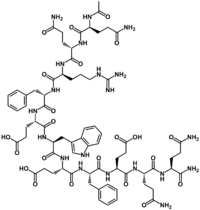Oligopetide P11-4
 | |
| Names | |
|---|---|
Other names
| |
| Identifiers | |
| 3D model (Jmol) | Interactive image |
| ChemSpider | 52082515 |
| |
| |
| Properties | |
| C72H98N20O22 | |
| Molar mass | 1,595.69 g·mol−1 |
| Except where otherwise noted, data are given for materials in their standard state (at 25 °C [77 °F], 100 kPa). | |
| | |
| Infobox references | |
P11-4 is a synthetic, pH controlled self-assembling peptide used for biomimetic mineralization e.g. for enamel regeneration[1] or as an oral care agent. P11-4 (INCI name Oligopeptide 104) consists of the natural occurring amino acids Glutamine, Glutamic acid, Phenylalanine, Tryptophan and Arginine.[2] The resulting higher molecular structure has a high affinity to tooth mineral.[3] P11-4 has been developed and patented by The University of Leeds, (UK). The Swiss company credentis has licensed the peptide technology and markets it under the registered trademark CUROLOX® TECHNOLOGY. They offer three products with this technology.[4] As of June 2016 in Switzerland products are available with new Brand names from Dr. Wild & Co AG.[5]
Mechanism of action
P11-4 is a self-assembling β-peptide.[6] It builds a 3-D bio-matrix with binding sites for Calcium-ions serving as nucleation point for Hydroxyapatite (tooth mineral) formation. The high affinity to tooth mineral is based on matching distances of Ca-ion binding sites on P11-4 and Ca spacing in the crystal lattice of hydroxyapatite. The matrix formation is pH controlled and thus allows control matrix activity and place of formation.
P11-4 in Dental applications
Self assembling properties of P11-4 are used to regenerate early caries lesions. By application of P11-4 on the tooth surface, the peptide diffuse through the intact hypomineralized plate into the early caries lesion body and start, due to the low pH in such a lesion, to self-assemble generating a peptide scaffold mimicking the enamel matrix. Around the newly formed matrix de-novo enamel-crystals are formed from calcium phosphate present in saliva. Through the remineralization caries activity is significantly reduced in comparison with a fluoride treatment alone.[7] In aqueous oral care gels the peptide is present as matrix. It binds directly as matrix to the tooth mineral and forms a stable layer on the teeth.[8] This layer does protect the teeth from acid attacks. It also occludes open dentin tubule and thus reduces the dental sensitivity
Uses
- Treatment of initial caries lesions
- Regenerating enamel
- Dentin Hypersensitivity
- Acid protection
Availability
Availability of products containing P11-4 vary by country, with some products available only to dentists, and others available to the retail public. Medical device for caries treatment and enamel regeneration:
- CURODONT REPAIR (EU)
- REGENAMEL (CH)
Cosmetic products for Acid protection and dentin desensitization:
- CURODONT PROTECT (EU)
- EMOFLUOR PROTECT GEL PROFESSIONAL (CH)
- CURODONT D’SENZ (EU & CH)
- EMOFLUOR DESENS GEL PROFESSIONAL (CH)
- Candia Protect Professional[9] (CH)
See also
- Amorphous calcium phosphate
- Remineralisation of teeth
- Oligopeptide
- Biomimetic materials
- Fluoride
- Recaldent
References
- ↑ Brunton, P.A.; Davies, R.P.W. (2 July 2013). "Treatment of early caries lesions using biomimetic self-assembling-peptides – a clinical safety trial". Brit Dent J. 215 (E6). doi:10.1038/sj.bdj.2013.741. PMID 23969679.
- ↑ "European Commission database with information on cosmetic substances and ingredients". Oligopeptide 104. Retrieved 1 July 2015.
- ↑ Kirkham, J; et al. (May 2007). "Self-assembling Peptide Scaffolds Promote Enamel Remineralization". J Dent Res. 86 (5): 426–430. doi:10.1177/154405910708600507.
- ↑ "credentis webpage". http://www.credentis.com. External link in
|website=(help); - ↑ AG, Touch Design. "Credentis: credentis ag and Dr. Wild & Co. AG strengthen their successful partnership". www.credentis.com. Retrieved 2016-06-29.
- ↑ Aggeli, A; Bell, M; et al. (20 March 1997). "Responsive gels formed by the spontaneous self-assembly of peptides into polymeric β-sheet tapes". Nature. 386: 259–262. doi:10.1038/386259a0. PMID 9069283.
- ↑ Alkilzy, M; et al. (May 15, 2015). "Efficacy, Clinical Applicability and Safety, of CurodontTM Repair in Children with Early Occlusal Caries". Caries Res. 49: 311. doi:10.1159/000381323.
- ↑ Chen, X; et al. (Sep 2014). "Dentine Tubule Occlusion of a Novel Self-n Vitro Evaluation of Dentine Remineralisation by a Self-Assembling Peptide Using Scanning Electron Microscopy". Caries Res. 48: 402. doi:10.1159/000360836. Retrieved 1 July 2015.
- ↑ "Candida Zahnpasta Protect Professional". Retrieved 1 July 2015.